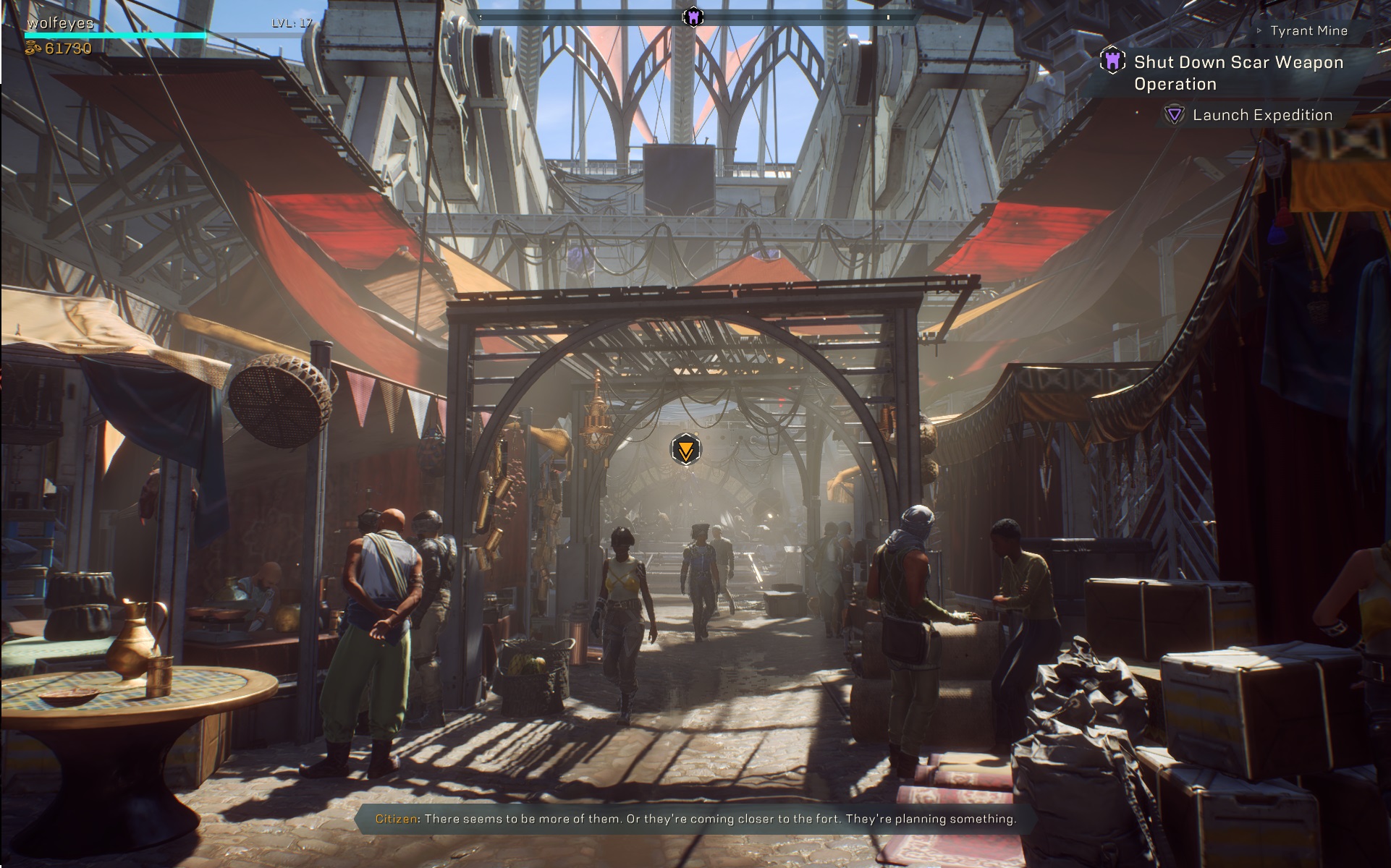iOS developers will soon be able to offer discounts to their existing and lapsed subscribers
As subscriptions continue to grow into a sizable revenue stream for mobile app developers, Apple has had to make adjustments to its guidelines, rules and even its tools for subscription management in recent weeks. It issued stricter guidelines around how subscriptions are to be presented to consumers, and it made the setting for canceling existing subscriptions more accessible. Now, Apple is rolling out new tools for developers that will help them retain their current customers and win back lapsed subscribers.
The company announced on Friday that apps with auto-renewable subscriptions will soon be able to offer their subscriptions at a discounted price for a specific period, as a means of growing and retaining their customer base. This will give the developers more control over their subscription pricing than was available before.
Until the change, developers could only make introductory offers to entice consumers to sign up for the first time. For example, developers could lure customers with a one-time introductory price, offer a free trial or offer a discounted rate for a specific period of time before the subscription converted to the full price.
But these offers could only be made to first-time customers. The new promotional offers will allow developers to cut similar deals for existing subscribers or to win back the business from those who used to pay for the subscription but had canceled.
While the new promotional offers allow for the same sort of discounts as introductory offers, they’re more flexible in terms of how they’re used.
With introductory offers, developers were allowed one offer per subscription, per territory. With promotional offers, developers can activate up to 10 offers per subscription. This allows them to test which ones work best for their customers, instead of having to pick just one.
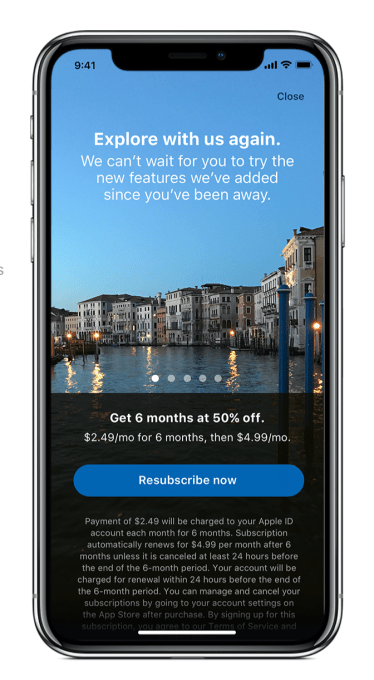 And developers are in control of when an offer displays to a customer, in which territories and how many offers a customer can redeem.
And developers are in control of when an offer displays to a customer, in which territories and how many offers a customer can redeem.
In addition, while introductory offers may display in the App Store when promoted, the promotional offers will not. That means developers can use business logic that targets winning back their most valuable customers with offers that may be better from those shown to others — and no one would be the wiser. It also means developers can offer different deals to lapsed customers — like maybe a discounted subscription — compared with promos meant to retain current subscribers.
Developers will also be able to use receipt validation tools to find subscribers who turned off auto-renewal, which allows them to target those customers with new offers before their subscription lapses. They may also decide to target those who cancel during the free trial with different offers than those who cancel after using a paid subscription for a time.
As an end-user looking to save money, these changes mean it may be worth toggling off your subscriptions from time to time to see if you’re offered a better deal to resubscribe.
Developers were alerted to the new features last week, but the offers themselves aren’t yet publicly available.
To create the offers, developers have to download the latest Xcode 10.2 beta and will need to implement the new StoreKit APIs. They can then test their offers on the latest beta version of iOS 12.2, macOS 10.14.4 and tvOS 12.2. Apple said the offers will be made available to the public “soon.”
Powered by WPeMatico
Bioware’s high-flying ‘Anthem’ falls flat
Anthem is the first attempt by Bioware (of Mass Effect and Dragon Age fame) to tap into the well of cash supposedly to be found in the “game as platform” trend that has grown over the last few years, with Destiny, Warframe and Fortnite as preeminent exemplars. After a botched demo weekend dampened fan expectations, the final game is here — and while it’s a lot better than the broken mess we saw a few weeks ago, it’s still very hard to recommend.
I delayed my review to evaluate the game’s progress after an enormous day-one patch. While it is always premature to judge a game meant to grow and evolve by how it is immediately after launch, there are serious problems here that anyone thinking of dropping the $60 or more on it should be aware of. Perhaps they’ll all be fixed eventually, but you better believe it’s going to take a while.
I’d estimate this is about half the game it’s clearly intended to be; it seems to me we must soon find out that most of Anthem, supposedly in development for five years or more, was scrapped not long ago and this shell substituted on short notice.
The basic idea of Anthem is that you, a “freelancer” who pilots a mechanized suit called a “javelin,” fly around a big, beautiful world and blast the hell out of anything with a red hostility indicator over its head, which in practice is damn near everything. Once you’re done, you collect your new guns and gadgets and head back to base to improve your javelin, take on new missions and so on.
If it sounds familiar, it’s basically an extremely shiny version of Diablo, which established this gameplay loop more than 20 years ago; its sequels and the innumerable imitators it spawned have refined the concept, bolstering it with MMO-style online integration, “seasons” of gameplay and, of course, the inevitable microtransactions. People play them simply because it’s fun to kill monsters and see your character grow more powerful.
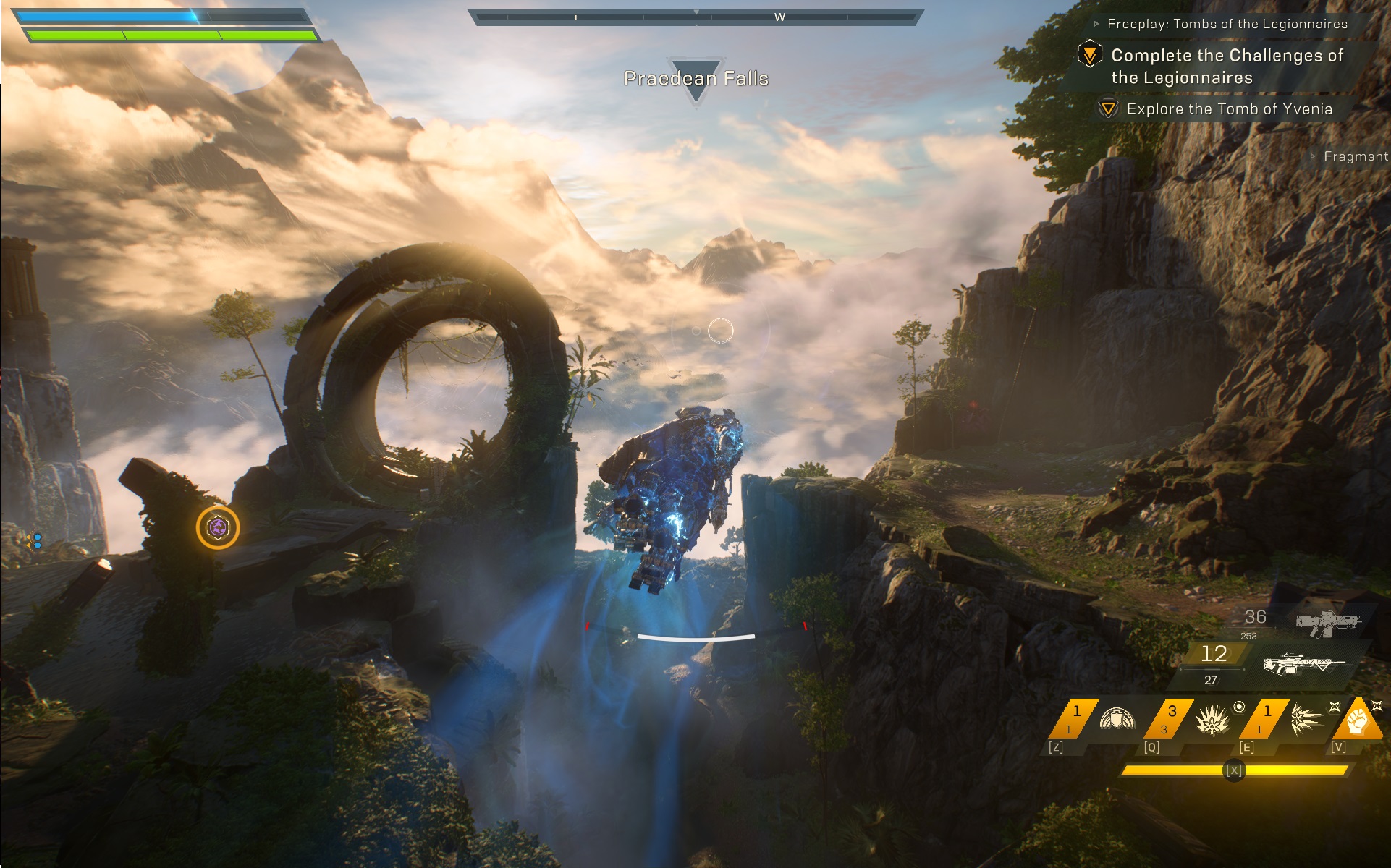 So Anthem is in good company, though of course for every success there are probably two or three failures and mediocre titles. Destiny has thrived in a way only because of its fluid and satisfying gunplay, while a game like Path of Exile leans on bulk, with skill trees and content one may never reach the ends of.
So Anthem is in good company, though of course for every success there are probably two or three failures and mediocre titles. Destiny has thrived in a way only because of its fluid and satisfying gunplay, while a game like Path of Exile leans on bulk, with skill trees and content one may never reach the ends of.
Anthem, on the other hand, lacks the charms of either. It is wildly short on content and its moment-to-moment gameplay, while competent and in some ways unique, rarely has you on the edge of your seat. It’s a very mixed bag of interesting concepts and disappointing execution, coupled with some truly baffling user experience issues.
I’ll cover the good parts first: the basics of flying around and shooting guys are for the most part solid. There’s a good variety of weapons, from hand cannons to shotguns and sniper rifles, with meaningful variations within those groups (though they usually boil down to rate of fire). You feel very cool during engagements, picking off enemies, dodging behind cover, flying to a new vantage point and so on.
Each of the four javelins has a good pile of themed special abilities that significantly affect how you play; for instance, the Storm starts out with (basically) non-damaging ice shards that freeze enemies, setting them up for a damaging combo from its lightning strike — but soon you can swap those out for fiery explosions and a charge-up blast of cold, and so on. The synergies are somewhat limited in that some abilities clearly only work with some others, but there’s fun to be had experimenting. I played with three of the four javelins available (more to come, apparently) and they were all very distinct styles.
The graphics really are lovely, from the future-past desert chic of Fort Tarsis to the lush jungle cliffs of the world you’ll be exploring. The light and landscapes are beautiful, and the character models are, too. Firefights look chaotic and splashy, which they are. There are also lots of customization options, in terms of colors and materials anyway — there’s a puzzling lack of cosmetics to buy with in-game or real currency; only two or three are available right now.
Unfortunately, that’s pretty much the extent of what Anthem gets right — and to be clear, it really can be fun when you’re actually in the middle of a firefight, blasting away, doing combos with friends, taking on hordes of bad guys. The rest is pretty much a mess. Here’s the greatest hits of how Anthem fails to operate, to respect the player’s time and, generally speaking, to be a good game.
First and perhaps most egregious, the load screens are frequent and long. I timed it at more than five minutes from launch, and at least three or four different load screens, before I could actually play the game.
A long load time to bring up a huge world like Anthem’s I can understand. But load times to enter the screen where you change your gear? Load screens when you enter a small cave from the map? A load screen when you stray too far from your teammates and have to be teleported to them? A load screen when you finish a mission, then another before you can return to base — and another before you can equip your new gun? Oh my god!
This is compounded by a sluggish and over-complicated UI that somehow manages to show both too much and not enough, while inconsistent keys and interaction elements keep you guessing as to whether you need to press F or space or escape to go forward, hit or hold escape to go back, use Q or E to go through submenus or if you have to escape out to find what you’re looking for.
Equipment and abilities are mystifyingly under-explained: no terms like “+15% gear speed” or “+/-10% shield time” are explained anywhere in the tutorial, documentation or character screen — because there is no character screen! For a game that depends hugely on stats and getting an overall feel for your build and gear, you have to visit five or six screens to get a sense of what you have equipped, its bonuses (if comprehensible) and whether you have anything better to use. Even core game systems like the “primer” and “detonator” abilities are only cursorily referenced, by cryptic icons or throwaway text. The original Diablo did it better, to say nothing of Anthem’s competition at the AAA level.
Navigating these menus and systems is doubly hard because you must do so not by just hitting a key, but by traveling at walking speed through the beautiful but impractical Fort Tarsis. It took a full 30 seconds for me to walk from my suit (the only place where you can launch missions) to a quest giver. And when you start the game, you start in a basement from which you have to walk 20 seconds to get to your suit! Are you kidding me?
Even when you’re doing what the game does best, zooming around and getting in firefights, there’s a disturbing lack of mission variety. Almost without exception you’ll fly to a little arena — some ruins or a base of some kind — and are immediately alerted of enemies in the area. They warp in at a convenient distance, often while you watch, and attack while you stand near a gadget (to advance a progress bar) or collect pieces to bring back. Some more powerful guys warp in and you shoot them. Fly to the next arena, rinse and repeat.
Sure, you could say “well it’s a shooter, what do you expect?” I expect more than that! Where are the aerial chases the intro leads you to believe exist? Enemies all either stand on the ground or hover just above it. They don’t clamber on the walls, get to the top of towers, shoot down on you from cliffs, climb trees, build gun emplacements. You don’t defend a moving target like the “Striders” (obviously AT-ATs) you supposedly travel in; bridges and buildings don’t crumble or explode; you don’t chase a bad guy into a big cave (or if you do, there’s a loading screen); the “boss-type” enemies are often just regular guys with more life or shields that recharge in the time it takes you to reload. Where are the enemy javelins? The enemy Striders? Ninety percent of what you kill will be ground-bound grunts taken down in a flash. For a game in which movement is emphasized and enjoyable, combat involves very little of it.
The campaign, which is surprisingly well acted but forgettable, seems like it was tacked on in a hurry. Amazingly, a major cutscene details a much more interesting story, in which a major city is overrun and destroyed and only a few survive. It struck me at the time that this might have been the original campaign and starting mission, after which you are logically relegated to the nearby Fort Tarsis and forced to fight for scraps. Instead you have a series of samey missions with voice-overs telling you what’s happening while you stand there and watch progress bars fill up.
 At one point you are presented with four ancient tombs to track down, only to find that these amazing tombs aren’t missions but simply checklists of basic game activities like opening 15 treasure chests, killing 50 enemies with melee and so on. At a point, increasing these numbers was literally the only “mission” I had available in the game. And when I tried to join other people’s missions to accomplish these chores, half the time they were broken or already finished. Even trying to quit these missions rarely worked! (Some of these bugs and issues have been mitigated by patches, but not all.)
At one point you are presented with four ancient tombs to track down, only to find that these amazing tombs aren’t missions but simply checklists of basic game activities like opening 15 treasure chests, killing 50 enemies with melee and so on. At a point, increasing these numbers was literally the only “mission” I had available in the game. And when I tried to join other people’s missions to accomplish these chores, half the time they were broken or already finished. Even trying to quit these missions rarely worked! (Some of these bugs and issues have been mitigated by patches, but not all.)
Spoiler warning! What do you think is in the tombs? A taxing dungeon full of traps, monsters and ancient treasure? Nope! Literally just a tiny, empty room. And yes, there’s a loading screen — both in and out.
Oh, and because many of the missions are difficult or tedious to do solo, you’ll want to team up — except if you’re slow to load, the mission will commence without you and you’ll miss the VO. Whoops! And by the way, if you just want to test out a new gun or power, you’ll have to join a multiplayer “freeplay” session to do it, which is another handful of loading screens. I’m not even going to get into the failings of the multiplayer. Because you can’t communicate it’s basically like playing with bots. By the way, there’s no PvP, so forget about skirmishing with your friends or randoms.
 Even the loot you get is frustratingly low-quality and unimaginative. Every gun or component is a standard model almost always with just slightly better damage than the last one you found, and perhaps a stat bonus. But the stat bonuses are boring and often nonsensical: do I really want an assault rifle that gives me 10 percent better damage with heavy pistols?
Even the loot you get is frustratingly low-quality and unimaginative. Every gun or component is a standard model almost always with just slightly better damage than the last one you found, and perhaps a stat bonus. But the stat bonuses are boring and often nonsensical: do I really want an assault rifle that gives me 10 percent better damage with heavy pistols?
Where’s the fun? For comparison when I was playing Diablo III recently I found a pair of leg armor early on that produced a powerful poison cloud whenever I was touching three or more enemies. Suddenly I played differently, rushing into crowds of monsters and leaping out, then immobilizing them while their life ticked down. I changed out my weapons, focused on physical defense, poison buffs… all because of a pair of pants!
I’ve encountered nothing like that in 25 hours of Anthem. Every new power and gun is the same as the old one but with a higher number. Where’s the lightning bolt that also sets people on fire, or the plasma blast that always knocks down flying guys? The pistol that does double damage against one class of enemy, the sniper rifle that automatically chambers a new round instantly in one out of five shots?
You do eventually find some “Masterwork” items that have unique qualities, but even these are compromised by the fact that their stats are completely random (such as a bonus to the wrong damage type), necessitating a grind to make or find them over and over until you get one with bonuses that make sense.
So much of Anthem seems like it’s just missing. The campaign is half there; the controls and UI are half there; the loot is half there. The multiplayer is half there. Everything lacks a critical piece that makes it more than basically functional, and considering the game’s highly polished competition, this is inexplicable and inexcusable. I find it hard to believe this was in the works for five years when such elementary aspects like a character screen and working item descriptions aren’t included at launch.
It’s more than possible that with perhaps half a year of work the Bioware team — which seems to be painfully aware of the game’s shortcomings, if their responses to detailed litanies of complaints on the game’s subreddit are any indication — could make this game worth the price of entry. But right now I couldn’t recommend it to anybody in good conscience, and I’m disappointed that a developer that’s created some of my favorite games dropped the ball so badly.
It’s too bad, because I feel the pull of the game, the basic chaotic fun at the heart of any good looter-shooter, because I feel like this can’t really be it. This can’t really be all my abilities, right? This can’t be every weapon? I liked Anthem when it was at its best, but that was so very little of the time I spent in it, and it took so much effort and patience on my part to even make those moments a possibility. I’ll be checking back in with the game in the hopes that it makes a Destiny-esque turnaround, but for now I have to say Anthem suffers from a failure to launch.
Powered by WPeMatico
Here are all the 5G phones announced at MWC
Mobile World Congress is underway, which means there are a handful of brand spankin’ new 5G phones hitting the market soon.
How ever will you decide?
Here’s a look at all the 5G phones announced thus far:
Huawei Mate X
The Mate X is a foldable 5G phone with one 4.6-inch screen, another 6.6-inch 2480×1148 screen and (when unfolded) an 8-inch 2200×2480 display.
Some other specs:
- Processor: Kirin 980
- Battery: 4,5000mAh
- Memory: 8GB RAM, 512GB internal
- Price: $2,600
- Size: 11mm folded, 5.4mm unfolded

LG V50 ThinQ 5G
Aside from its unbearably long name, the LG V50 ThinQ 5G’s claim to fame is a new biometric security measure called Hand ID, which reads the veins in your hand to authenticate your identity. Plus, the new LG flagship has a dual-screen case, which effectively turns the phone into a foldable.
Some other specs:
- Processor: Qualcomm SDM855 Snapdragon 855
- Battery: 4,000mAh
- Memory: 6GB RAM, 128GB internal
- Price: Unknown
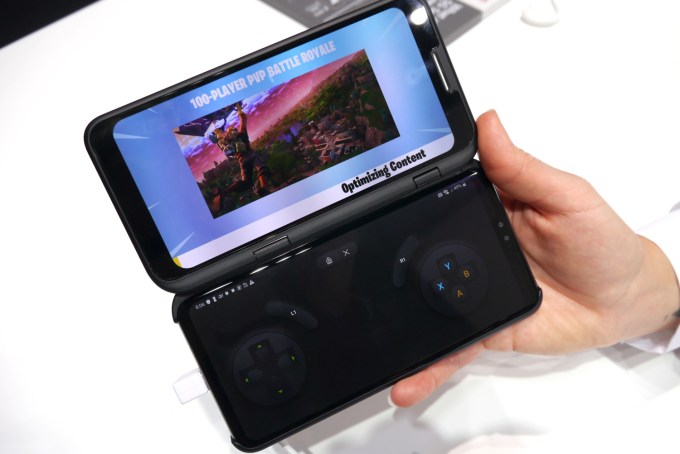
Samsung Galaxy Fold
The Galaxy Fold is likely to be the most talked-about phone out of MWC because 1) it folds and 2) it’s made by the biggest phone maker in the world. The handset, with a 7.3-inch 1536×2152 Super AMOLED unfolded display and a 4.6-inch cover display, will be available April 26.
Some other specs:
- Processor: Qualcomm SDM855 Snapdragon 855
- Battery: 4,380mAh
- Memory: 12GB RAM, 512GB internal
- Price: $1,980
- Size: 17mm folded

Samsung Galaxy S10 5G
The Samsung S10 5G is exactly what you would expect it to be. It’s packed with all the bells and whistles that might appeal to the customer who wants the top of the line phone regardless of price. It sports a 6.7-inch 1440×3040 AMOLED display.
Some other specs:
- Processor: Qualcomm SDM855 Snapdragon 855
- Battery: 4,500mAh
- Memory: 8GB RAM, 256GB internal
- Price: Unknown
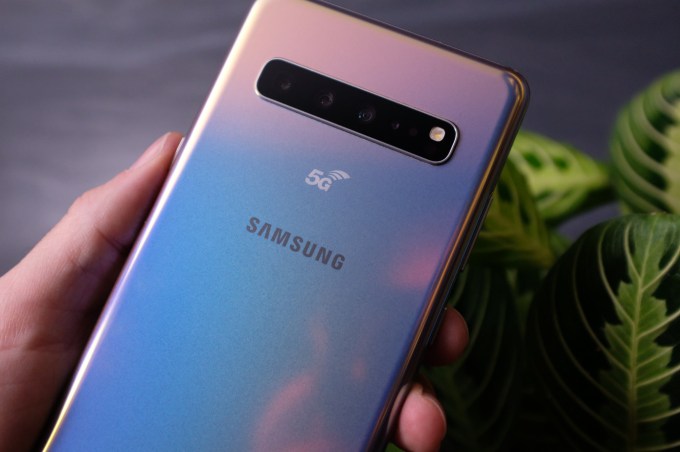
Xiaomi Mi Mix 3
Interestingly, Xiaomi opted to leave 5G out of its flagship phone for the year, the Mi 9. That said, the 5G Mi Mix 3 has a handful of its own interesting features, including a sliding front-facing camera that results in a 93.4 percent screen-to-body ratio. It also has a dual-camera system that offers the ability to shoot slow-mo videos at 960 frames per second.
Some other specs:
- Processor: Qualcomm SDM855 Snapdragon 855
- Battery: 3,800mAh
- Memory: 6GB RAM, 64GB/128GB internal
- Price: $680
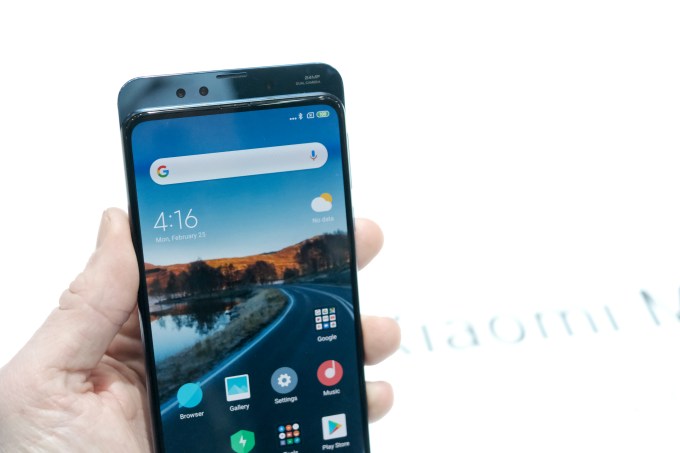
ZTE Axon 10 Pro 5G
The Axon 10 Pro 5G doesn’t have many tricks, like a folding display, but it does come with a triple-camera system and what appears to be an in-display fingerprint reader. It also sports a 6.7-inch 1080p display. The phone will definitely launch in Europe and China, but no word on whether it will make its way stateside.
Some other specs:
- Processor: Qualcomm SDM855 Snapdragon 855
- Battery: 4,000mAh
- Memory: 6GB RAM, 128GB internal
- Price: Unknown
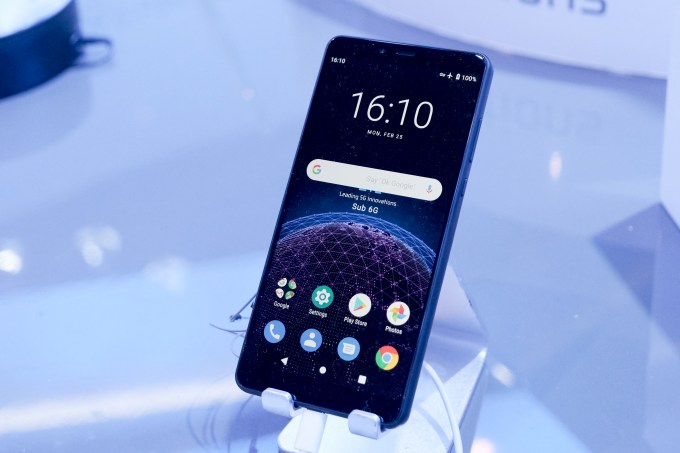
Powered by WPeMatico
Europe is prepared to rule over 5G cybersecurity
The European Commission’s digital commissioner has warned the mobile industry to expect it to act over security concerns attached to Chinese network equipment makers.
The Commission is considering a defacto ban on kit made by Chinese companies including Huawei in the face of security and espionage concerns, per Reuters.
Appearing on stage at the Mobile World Congress tradeshow in Barcelona today, Mariya Gabriel, European commissioner for digital economy and society, flagged network “cybersecurity” during her scheduled keynote, warning delegates it’s stating the obvious for her to say that “when 5G services become mission critical 5G networks need to be secure”.
Geopolitical concerns between the West and China are being accelerated and pushed to the fore as the era of 5G network upgrades approach, as well as by ongoing tensions between the U.S. and China over trade.
“I’m well away of the unrest among all of you key actors in the telecoms sectors caused by the ongoing discussions around the cybersecurity of 5G,” Gabriel continued, fleshing out the Commission’s current thinking. “Let me reassure you: The Commission takes your view very seriously. Because you need to run these systems everyday. Nobody is helped by premature decisions based on partial analysis of the facts.
“However it is also clear that Europe has to have a common approach to this challenge. And we need to bring it on the table soon. Otherwise there is a risk that fragmentation rises because of diverging decisions taken by Member States trying to protect themselves.”
“We all know that this fragmentation damages the digital single market. So therefore we are working on this important matter with priority. And to the Commission we will take steps soon,” she added.
The theme of this year’s show is “intelligent connectivity”; the notion that the incoming 5G networks will not only create links between people and (many, many more) things but understand the connections they’re making at a greater depth and resolution than has been possible before, leveraging the big data generated by many more connections to power automated decision-making in near real time, with low latency another touted 5G benefit (as well as many more connections per cell).
Futuristic scenarios being floated include connected cars neatly pulling to the sides of the road ahead of an ambulance rushing a patient to hospital — or indeed medical operations being aided and even directed remotely in real-time via 5G networks supporting high resolution real-time video streaming.
But for every touted benefit there are easy to envisage risks to network technology that’s being designed to connect everything all of the time — thereby creating a new and more powerful layer of critical infrastructure society will be relying upon.
Last fall the Australia government issued new security guidelines for 5G networks that essential block Chinese companies such as Huawei and ZTE from providing equipment to operators — justifying the move by saying that differences in the way 5G operates compared to previous network generations introduces new risks to national security.
New Zealand followed suit shortly after, saying kit from the Chinese companies posed a significant risk to national security.
While in the U.S. President Trump has made 5G network security a national security priority since 2017, and a bill was passed last fall banning Chinese companies from supplying certain components and services to government agencies.
The ban is due to take effect over two years but lawmakers have been pressuring to local carriers to drop 5G collaborations with companies such as Huawei.
In Europe the picture is so far more mixed. A UK government report last summer investigating Huawei’s broadband and mobile infrastructure raised further doubts, and last month Germany was reported to be mulling a 5G ban on the Chinese kit maker.
But more recently the two EU Member States have been reported to no longer be leaning towards a total ban — apparently believing any risk can be managed and mitigated by oversight and/or partial restrictions.
It remains to be seen how the Commission could step in to try to harmonize security actions taken by Member States around nascent 5G networks. But it appears prepared to set rules.
That said, Gabriel gave no hint of its thinking today, beyond repeating the Commission’s preferred position of less fragmentation, more harmonization to avoid collateral damage to its overarching Digital Single Market initiative — i.e. if Member States start fragmenting into a patchwork based on varying security concerns.
We’ve reached out to the Commission for further comment and will update this story with any additional context.
During the keynote she was careful to talk up the transformative potential of 5G connectivity while also saying innovation must work in lock-step with European “values”.
“Europe has to keep pace with other regions and early movers while making sure that its citizens and businesses benefit swiftly from the new infrastructures and the many applications that will be built on top of them,” she said.
“Digital is helping us and we need to reap its opportunities, mitigate its risks and make sure it is respectful of our values as much as driven by innovation. Innovation and values. Two key words. That is the vision we have delivered in terms of the defence for our citizens in Europe. Together we have decided to construct a Digital Single Market that reflects the values and principles upon which the European Union has been built.”
Her speech also focused on AI, with the commissioner highlighting various EC initiatives to invest in and support private sector investment in artificial intelligence — saying it’s targeting €20BN in “AI-directed investment” across the private and public sector by 2020, with the goal for the next decade being “to reach the same amount as an annual average” — and calling on the private sector to “contribute to ensure that Europe reaches the level of investment needed for it to become a world stage leader also in AI”.
But again she stressed the need for technology developments to be thoughtfully managed so they reflect the underlying society rather than negatively disrupting it. The goal should be what she dubbed “human-centric AI”.
“When we talk about AI and new technologies development for us Europeans it is not only about investing. It is mainly about shaping AI in a way that reflects our European values and principles. An ethical approach to AI is key to enable competitiveness — it will generate user trust and help facilitate its uptake,” she said.
“Trust is the key word. There is no other way. It is only by ensuring trustworthiness that Europe will position itself as a leader in cutting edge, secure and ethical AI. And that European citizens will enjoy AI’s benefits.”
Powered by WPeMatico
OnePlus demos a 5G prototype at MWC
OnePlus promised us a 5G handset this year. At Mobile World Congress this week, the company kind of, sort of delivered. Unlike the sea of other 5G devices unveiled at the show, however, the company’s offering is still very much in the prototype phase — like, behind protective glass with all of the interesting bits obscured, as it isn’t officially official.
The product appeared at Qualcomm’s booth this week, since OnePlus’ presence at the show has been mostly limited to closed-door events. For the chipmaker, it was an opportunity to show yet again how ubiquitous its tech has become in the vast sea of Android devices.
“At Qualcomm Technologies’ booth, OnePlus simulated a futuristic setting of 5G cloud gaming where players would only need a smartphone and a gamepad,” Qualcomm explains. “Through the powerful capabilities of cloud processing as well as the throughput and responsiveness of 5G, players can play large sized games online that are generally only playable after downloading onto the PC first. Utilizing Snapdragon elite gaming features and optimizations, players were able to experience high definition and low latency cloud gaming like never before.”
Based on past release schedules, we can likely expect OnePlus to officially debut its next handset in the summer. Past release cycles have also seen a point upgrade later in the yea,r as well, though the company has been shifting things around a bit, as it continues to grow and figure out where it best fits in the broader handset market.
This particular device, likely the OnePlus 7, is due out in Q2, though, sadly, its 5G variant won’t be released in the States in 2018.
The addition of 5G in 2019, meanwhile, finds OnePlus taking a more cutting-edge approach to its release cycle, rather than holding back in order to lower the price tag on technology.
Powered by WPeMatico
New microSD format promises insane transfer speeds, better battery life
Today at MWC Barcelona the SD Association unveiled microSD Express, which will allow future mobile devices to consume and create content at even faster speeds. This new microSD card platform boosts incredible transfer speeds while consuming less energy used by previous formats.
The new format will be available in the flavors of microSDHC Express, microSDXC Express and microSDUC Express.
Like SD Express, microSD Express taps the PCIe interface to hit a maximum data transfer rate of 985 megabytes per second (MB/s). This is possible through the PCIe 3.1 and NVMe v1.3 specifications that live on a second row of pins. The SD Association expects the faster cards to consume less energy than traditional memory cards while still being backward compatible.
The fast data speeds could lead mobile device makers to rethink how they equip devices. Read and write speeds have long been a limiting factor for expandable memory, but with this new format, which is backward compatible, the data transfer happens nearly as quickly as built-in memory. With 5G data and cameras pumping out huge files, expandable memory could make a comeback.
Want more technical information about #microSDExpress? Learn more in our newest whitepaper: https://t.co/SyVdzdwGbN pic.twitter.com/3kmsdvjJhh
— SD Association (@SD_Association) February 25, 2019
Powered by WPeMatico
Don’t worry, ZTE has a 5G phone, too
There’s another name to add to the ever-lengthening list of 5G phones hitting Barcelona this week. ZTE just announced the Axon 10 Pro 5G, which is due out in the first half of 2019 — in China and Europe, at least. The States are a different question altogether, of course. ZTE hasn’t been quite the same political flash point as Huawei in recent years, but the company’s been subject to its own scrutiny from U.S. authorities.
Also like Huawei, ZTE’s got the marked benefit of building its own 5G networking equipment, which puts the Chinese smartphone maker ahead of much of the competition in terms of testing. At present, it’s working with carriers to ready its phone for the imminent arrival of the next-gen wireless tech.
In fact, the company used the kickoff of MWC today to showcase some of its own 5G tech, including a live presentation executed alongside Qualcomm. From this morning’s release:
The demonstration over 5G NR radio utilizes a real-world end-to-end 5G NR network built with ZTE’s commercial core network and radio base station equipment, as well as a ZTE 5G smartphone powered by the world’s first commercial 5G mobile platform—the Qualcomm Snapdragon 855Mobile Platform paired with the Snapdragon X50 5G modem, as well as Qualcomm Technologies’ RF transceiver and RF front-end solutions.
The forthcoming device also sports three rear-facing cameras, a U-shaped hole-punch bezel and what appears to be an in-display fingerprint reader. ZTE also launched the Blade V10 today. That handset features a 32-megapixel front-facing camera, because you can never have enough high-resolution selfies.
Powered by WPeMatico
Behold the Samsung Galaxy Fold under glass
Samsung decided to forgo the Mobile World Congress pomp and circumstance, instead opting to unveil its new products through its own party last week in San Francisco. I’ve been carrying around a Galaxy S10 for a few days now, so more on that soon. In the meantime, here’s the device everyone is really interested in.
As promised, the Galaxy Fold was on display at the company’s booth this morning, but it was protected by security rope and thick panes of glass, like so many carbonited Han Solos. Not folding and unfolding — just static, playing videos while throngs of reporters elbowed one another, jockeying for a bit of space.

It’s not a production device just yet. And honestly, it’s not the kind of display that engenders a lot of faith that the product will be coming to market in just under two months. At least it’s a step ahead of where we saw it late last year.
In the meantime, there’s this new video from Samsung. It’s a highly controlled “demo,” devoid of soundtrack (with some ASMRy sound effects). It shows more of the Fold than we’ve seen so far — which, granted, isn’t a particularly high bar, as far as these things go. You can, however, see folding and unfolding, and the same Wireless PowerShare feature you’ll find on the S10 and DeX functionality for bringing contact to an even larger screen via USB-C.

You can also catch glimpses of the App Continuity feature, which picks up your workflow where you left off, even as you switch between screens. But again, how that sort of thing plays out in person versus a video shot and edited by Samsung is a different question altogether. The positioning of the product at MWC leaves one wondering whether the company has worked through all of the software kinks.
At least we can see that the hardware exists in the world. We know there are four of these things in the world, each of which was on display behind glass (two with the screen facing out and two with the rear). We also know that, like Huawei’s device, the fold crease is highly visible when the light catches it. How much of an impact that will ultimately have on, say, the movie-viewing experience is another one of those open questions.
But Samsung is a big company with a lot of resources, and it’s got roughly two months to make sure everything is in working order on the device. Given the $1,899 starting price, it no doubt wants to get everything right. The clock is ticking.
Powered by WPeMatico
Qualcomm’s new 4G, 5G platforms to bring improved telecommunication to vehicles
Qualcomm today announced new 4g and 5g chipsets for connected vehicles. The chip maker sees the advanced communication platforms powering the next wave of in-vehicle experiences and telematics features including advanced automotive safety features and self-driving cars. Qualcomm says vehicles equipped with these chipsets are planned for production in 2021.
The Qualcomm Snapdragon Automotive 4G and Qualcomm Snapdragon Automotive 5G Platform feature C-V2X direct communications, high-precision multi-frequency global navigation satellite system (HP-GNSS) and RF Front-End (RFFE) functionalities — basically, the chipsets will give vehicles next level positioning capabilities.
Along with improved positioning, vehicles equipped with these Snapdragon platforms gain vehicle-to-vehicle and vehicle-to-infrastructure communications.
The Snapdragon Automotive 5G chipset is the first in the industry announced with support for dual SIM dual active — or DSDA, for short.
Qualcomm says it intends to give automakers the ability to test the platforms with a reference design kit in the second half of 2019.
It’s through chipsets like these that vehicles will gain autonomous driving capabilities. Without advanced, reliable connectivity, vehicles will not have access to the data needed to navigate across the ever-evolving urban landscape. While current systems are being used to some level of success, improved connectivity is ultimately needed to make good on the promise of self-driving cars.
Powered by WPeMatico
Qualcomm wants your phone to drive your next VR and AR headsets
Qualcomm wants to create a new device category, XR viewer headsets, that combine the compute power of its current Snapdragon 855 platform with the speed of 5G on a smartphone to provide you with mobile VR and AR experiences — or ‘Extended Reality,’ as Qualcomm likes to call it — with six degrees of freedom tracking. The company announced this new initiative at MWC in Barcelona and noted that it expects OEMs like Pico to launch devices later this year.
The idea here is that the headsets will be tethered to a smartphone via a USB-C connection that drives high-res displays, with a lot of the content being streamed over — ideally – a 5G connection.
 The headsets are an extension of the company’s previous XR work which mostly focused on using a phone’s camera’s and displays to power AR experiences. The company did start an accelerator program for head mounted displays (HMD), the aptly named HMD accelerator program, back in 2017. In many ways, today’s announcement is an extension of this work.
The headsets are an extension of the company’s previous XR work which mostly focused on using a phone’s camera’s and displays to power AR experiences. The company did start an accelerator program for head mounted displays (HMD), the aptly named HMD accelerator program, back in 2017. In many ways, today’s announcement is an extension of this work.
“Our HMD Accelerator Program has been a critical catalyst for ecosystem partners ranging from component suppliers and ODMs, to bring quality standalone XR headsets to consumers,” said Hugo Swart, senior director, Product Management, Qualcomm. “Building upon the momentum of this program, we will extend this to XR viewers and compatible smartphones, starting with smartphones enabled by the Snapdragon 855 Mobile Platform.”
Qualcomm has signed up a number of platform and software partners like Arvizio, NetEase-AR, Iconic Engine, NextVR, SenseTime and Wikitude, as well as manufacturers like Acer and Asus.
Powered by WPeMatico



